Stuffed, Starved or Satisfied
Help yourself to a glass of bubbles and I’ll explain how you can apply your party planning skills to improve your LinkedIn Ads budgeting.
Reading: 0118 322 4395 | Manchester: 0161 706 2414 | Oxford: 01865 479 625 | info@sharpahead.com | Office hours: Monday-Friday 9:00am - 5:30pm
| Office hours: Monday-Friday 8:30am - 5:30pm
| Email | Office hours: Mon-Fri 9:00am - 5:30pm
Measurement and Optimisation for B2B Landing Pages
B2B Lead Gen Landing Pages part 6
In previous articles we’ve looked at why landing pages are so important for B2B lead gen, how to design a high-converting landing page, the important roles of the CTA and the form in the conversion journey, and some of the technology and governance considerations.

It’s hard to design a good B2B lead gen landing page. As we covered in earlier articles, there are brutal trade-offs. The process can be exhausting. Once you’re happy with your initial page design you could be forgiven for never wanting to look at it again!
But forgetting about your live landing pages is a missed opportunity. From the moment a landing page goes live you can start to gather information about how it is performing in the real world, with real users. Over time that information can build into a picture that will let you revisit some of your earlier design decisions and create a better-performing version of the page.
If you can improve the performance of your landing pages over time, you’ll get better results and better return on investment from the campaigns that use them. And you’ll also refine your ideas of best practices so that you have a better starting point for any future landing pages you look to build. That’s a big, long-term win.
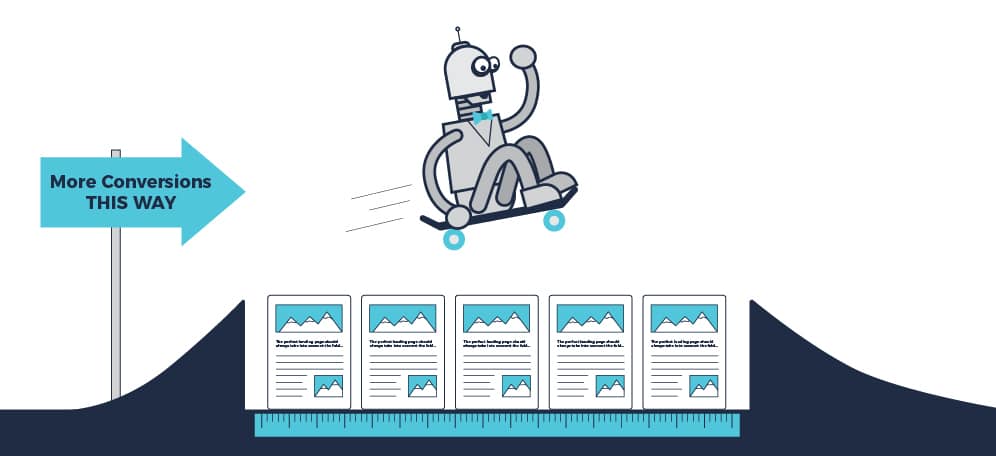
We have mentioned this before a time or two but sadly, A/B testing (aka split testing) isn’t likely to be the best approach to optimising a B2B landing page. The main reason – you need a LOT of conversions to run a reliable A/B test. Here’s our robot landing page butler Clicksworth to illustrate the problem.
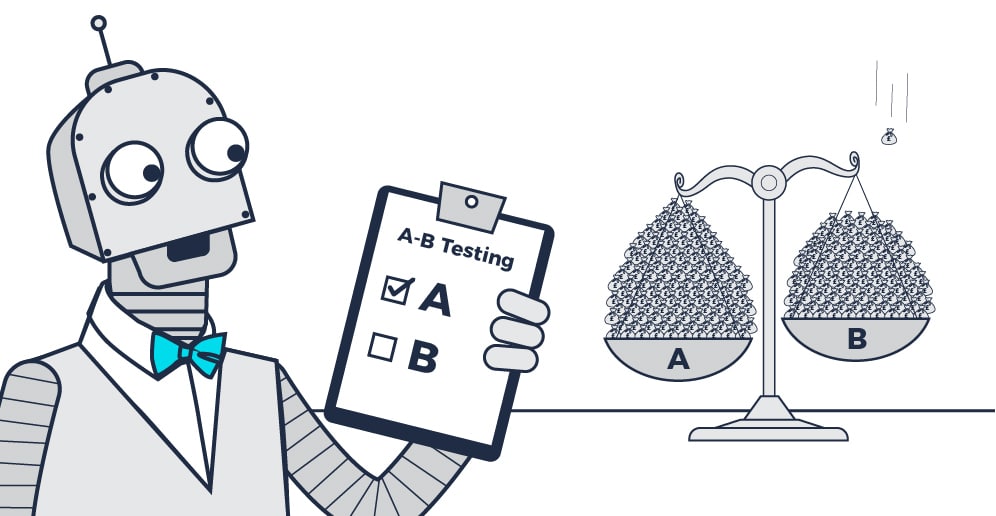
Here Clicksworth is running a typical B2C A/B test with hundreds of conversions. It’s a safe choice to pick version A. Even the one extra conversion on its way to version B isn’t going to tip the scales.
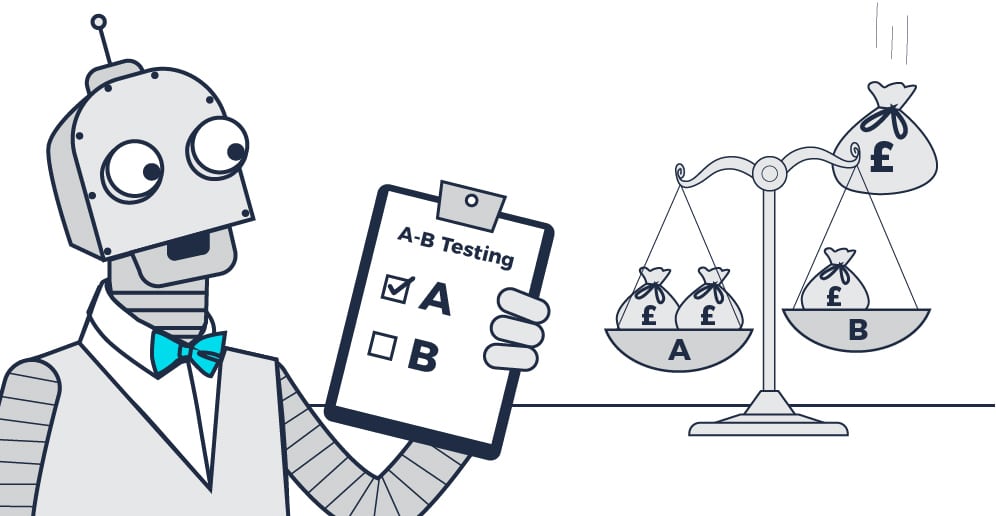
In this B2B example Clicksworth has just made an expensive mistake. If the A/B test had run even a little longer, the B version of the page would have started to win out. With only a few conversions, the A/B test isn’t able to reliably tell which version is better.
If you’re lucky enough to have hundreds of conversions every month, and you have two strong candidates for a particular design choice and no better way to choose between them, then for sure go ahead and run an A/B test. But for most B2B digital marketers that’s not possible.
We’re going to need some other approach to B2B landing page optimisation. And to optimise we need to measure. But what do we measure?
It’s tempting to say that the “conversion rate” of a landing page is the most important measure. For sure, a high-performing B2B landing page should have a high conversion rate. But the conversion rate is the end result of pretty much every choice you made about your page, and every choice about the traffic you send to it, compounded together. If a page has a low conversion rate, that could be because the page is slow to load, or because the header copy isn’t very persuasive, or the call to action is unclear, or some important design element is below the fold, or a form has too many fields, or because you’re sending poorly-qualified traffic…or many other things. So knowing the conversion rate of a landing page isn’t a very useful guide as to WHAT to optimise.
Saying you want a landing page to have a good conversion rate is like saying you want your car to be fast. You could make your car faster by upgrading the engine, or cleaning the spark plugs, or switching to premium fuel, or taking some heavy luggage out of the boot – or just by driving it downhill! You need more information to focus on the specific changes that offer the best route to improvements.
The idea of “optimising” a landing page sounds appealing but is dangerously vague. To focus our discussion let’s be specific about the types of changes that you might realistically consider making in order to improve the performance of a live landing page. Here are some examples of changes that you might reasonably consider:
Have a think about those types of changes for a moment. What type of data would help you to make better decisions about whether to make a change of that type, and about what specific change to make?
Fortunately one aspect of landing page measurement is pretty straightforward, thanks to the Google-supported Core Web Vitals framework. You don’t even need to wait for your campaigns to go live – you can use the free Page Speed Insights tool to test the page before you start sending traffic to it.
Core Web Vitals and Page Speed Insights will give you great information about the technical aspects of your page’s user experience. You might, for example, find that it is too slow to load. The tools will even recommend ways to improve things (such as by reducing file sizes for specific images).
The takeaway: test your landing pages with Page Speed Insights and look to score well on the Core Web Vitals metrics. And test again after any page design or technical setup changes, in case you’ve inadvertently harmed your Core Web Vitals scores as the result of a well-intentioned change.
There’s another quick win in landing page user experience measurement and optimisation.
Tools like Microsoft Clarity can produce scroll depth heatmaps. (You can also obtain similar information about scroll depth from Google Analytics and many other tools.) Scroll depth measurement lets you see how many users are reaching a given depth on the page.
There are several ways you can use scroll depth as a guide in optimising your landing pages, but here’s the simplest and most powerful one: page content that a user doesn’t see can’t have any impact. So for example if you have a persuasive customer testimonial deep in your page, and you can see from scroll depth analysis that only 5% of your users ever see it, you know that 95% of its possible impact has been lost.
Here’s an example from one of our own landing pages (if you’re curious you can see the live page at https://sharpahead.com/linkedin-ads-agency/).
A key feature of this page is a call booking widget that we use to allow the visitor to book a meeting. On desktop, this scroll heat map from Clarity shows us that around 54% of our visitors scroll down far enough to see that widget:
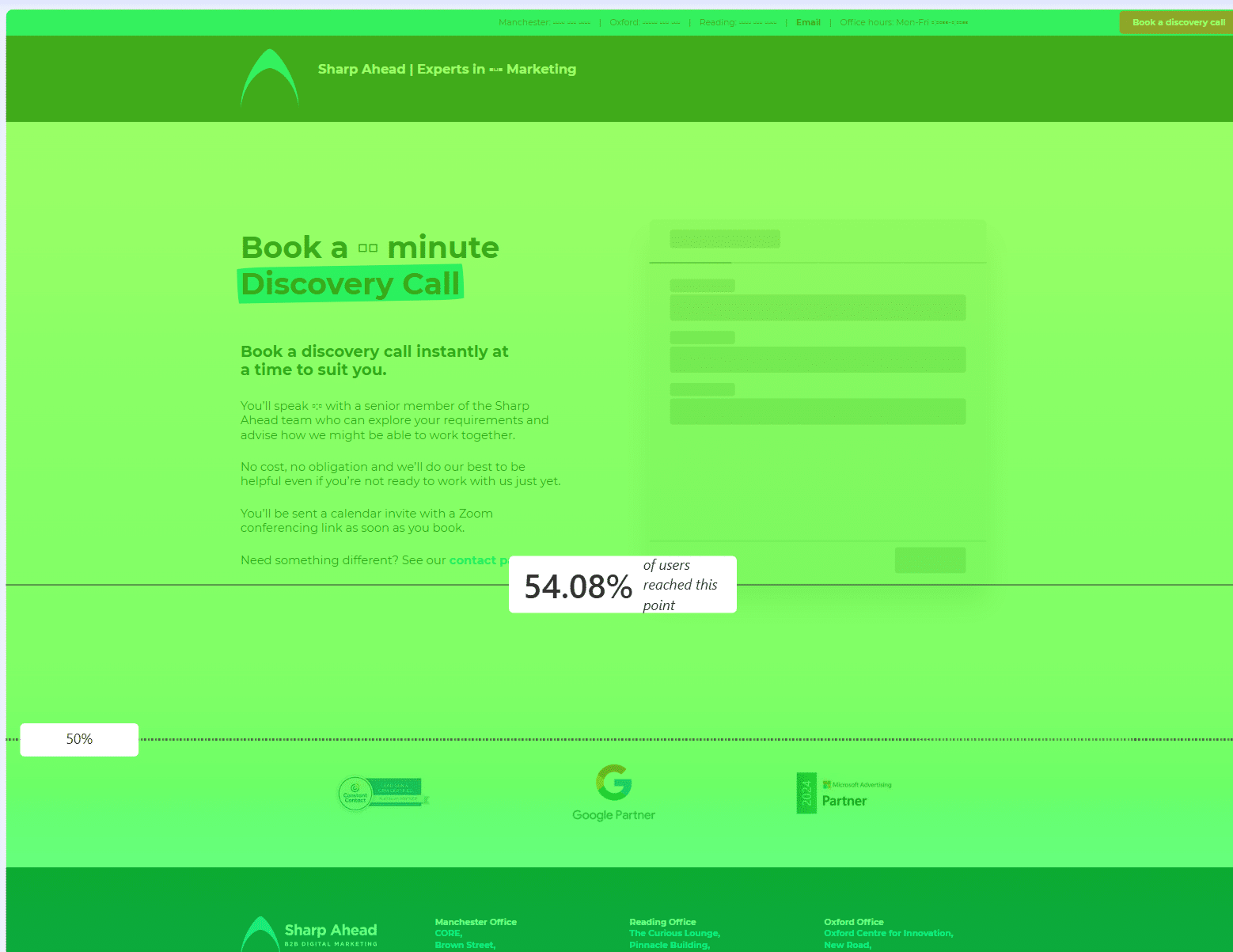
That’s not too bad. This feature is deep on the page, so getting more than half of our visitors to see it suggests that we’ve done a reasonably good job of keeping them engaged.
On mobile it’s a slightly different story:
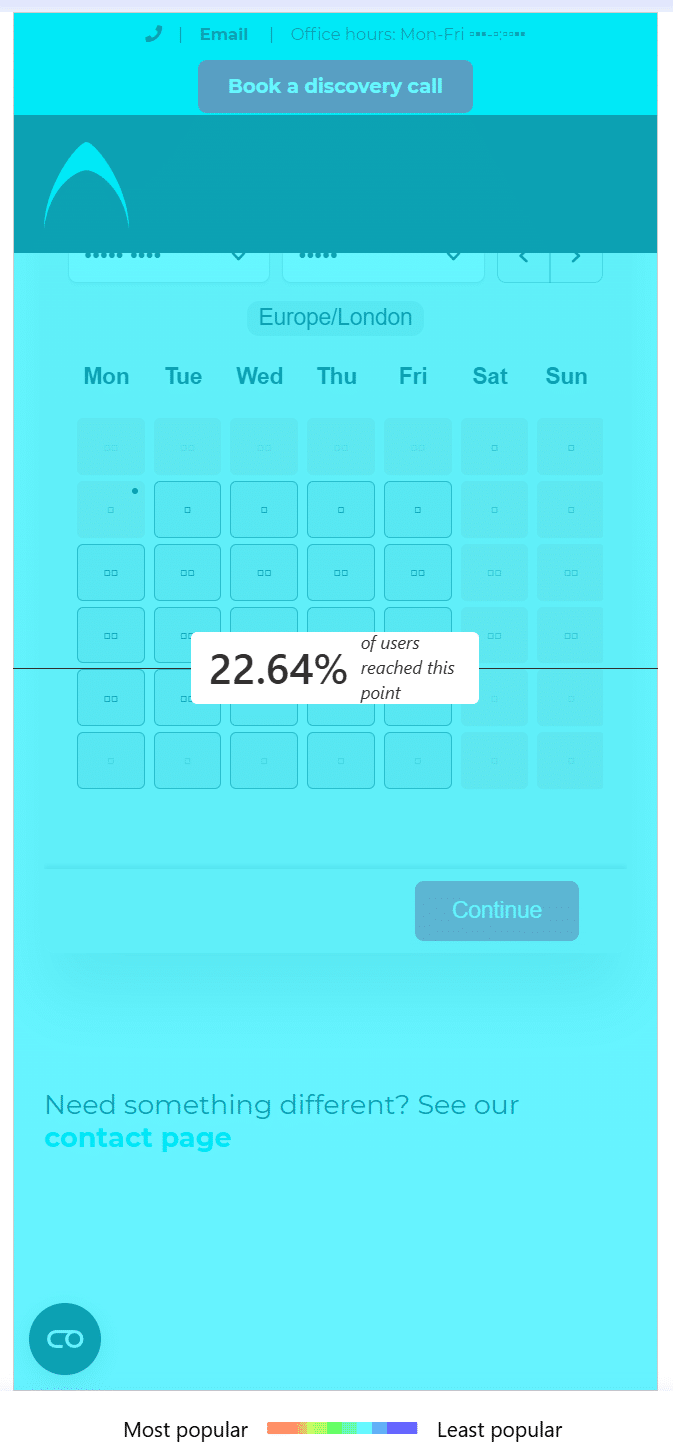
More than 75% of our mobile visitors have left the page without seeing the booking widget. That gives us a bit more cause for concern. We need to consider moving the widget higher on the mobile layout of the page, or doing something else to improve engagement for mobile visitors.
The takeaway: use a scroll depth measurement tool on your landing pages and use it to sanity check your information architecture. If you have important content languishing unseen at the bottom of a page, move it higher up!
For more complex user experience issues on landing pages, screen recording is a fantastic tool.
We are fans of the free tool Microsoft Clarity, which produces useful screen recordings (and a bunch of other useful reports) with minimal fuss. Other screen recording tools are available too.
Once you’ve put your landing page live for users, take a look at their screen recordings. Some of the things you might find include:
There’s a bit of an art to interpreting screen recordings. Make sure you look at a good number of them all together, rather than just focussing on one or two. And it’s a good idea to look at recordings of both successful visits (that include a conversion) and unsuccessful ones. But if you don’t mind putting in the work, screen recordings are a great guide to figuring out how users are really interacting with your landing page and where there might be issues that are undermining performance.
The takeaway: at least set up a screen recording tool on your landing pages so you have the option to inspect the recordings. The cost is low and the potential future value is high.
Some of the other techniques we’ve mentioned might lead you to suspect that header or body copy needs to be changed, or that you need to trial a different CTA.
Measurement tools can only help so much with this. For example a heatmap can show you that the user scrolled the page in such a way that they had a chance to read a piece of copy, but can’t tell you whether they actually read it, or whether it conveyed the meaning that you intended.
If you want to experiment with copy and CTAs, you can derisk the associated changes with a user research technique like 5 second user testing. This sort of user testing can’t tell you for sure whether your alternative will be better, but it can at least iron out any major issues – for instance if your new copy isn’t as clear as you think, or if your CTA is confusing for some reason that you’ve not spotted.
The takeaway: consider 5 second user testing and other lightweight user testing methodologies to derisk landing page changes, especially ones that are hard to measure in other ways.
Finally we need to admit that landing page measurement can only go so far. If your form isn’t getting as many conversions as you’d like, there’s nothing you can measure that will tell you exactly WHY that is.
The best practices around landing page design that we’ve set out in the rest of this series are just as relevant for optimising existing pages as for designing new ones.
The takeaway: make sure you are familiar with landing page design best practices and keep them in mind when you are considering optimisations.
We’ve covered a lot in this series. Building, maintaining and optimising state-of-the-art B2B lead gen landing pages requires many different skills and technologies. But if you can get to grips with the complexity, the impact on your B2B marketing success can be massive – high-performing landing pages multiply up the cost-effectiveness of everything else in your digital marketing mix.
We hope we’ve inspired you with fresh ideas you can bring to your own B2B lead gen campaigns!
Have more questions about crafting high-performing landing pages, or B2B marketing in general? Please get in touch, one of our consultants would be happy to chat!
Receive our biweekly newsletter and stay up to date with the latest B2B digital marketing news and insights.
Help yourself to a glass of bubbles and I’ll explain how you can apply your party planning skills to improve your LinkedIn Ads budgeting.
It’s a tough market out there with sales cycles continuing to lengthen over the past year
The B2B buying journey is changing at a fast pace, and B2B marketers must evolve their brand’s digital footprint now or risk obscurity in this new world.